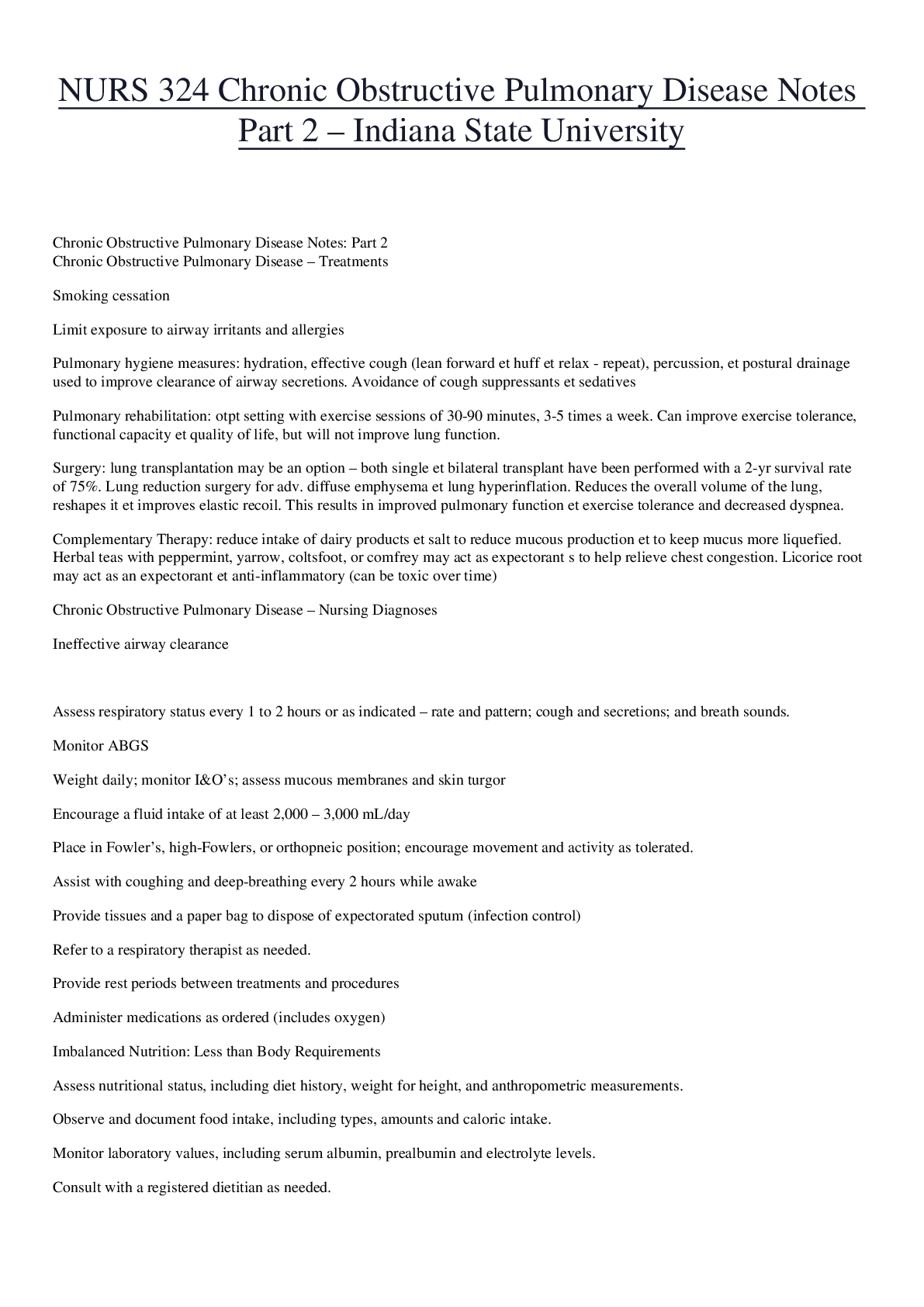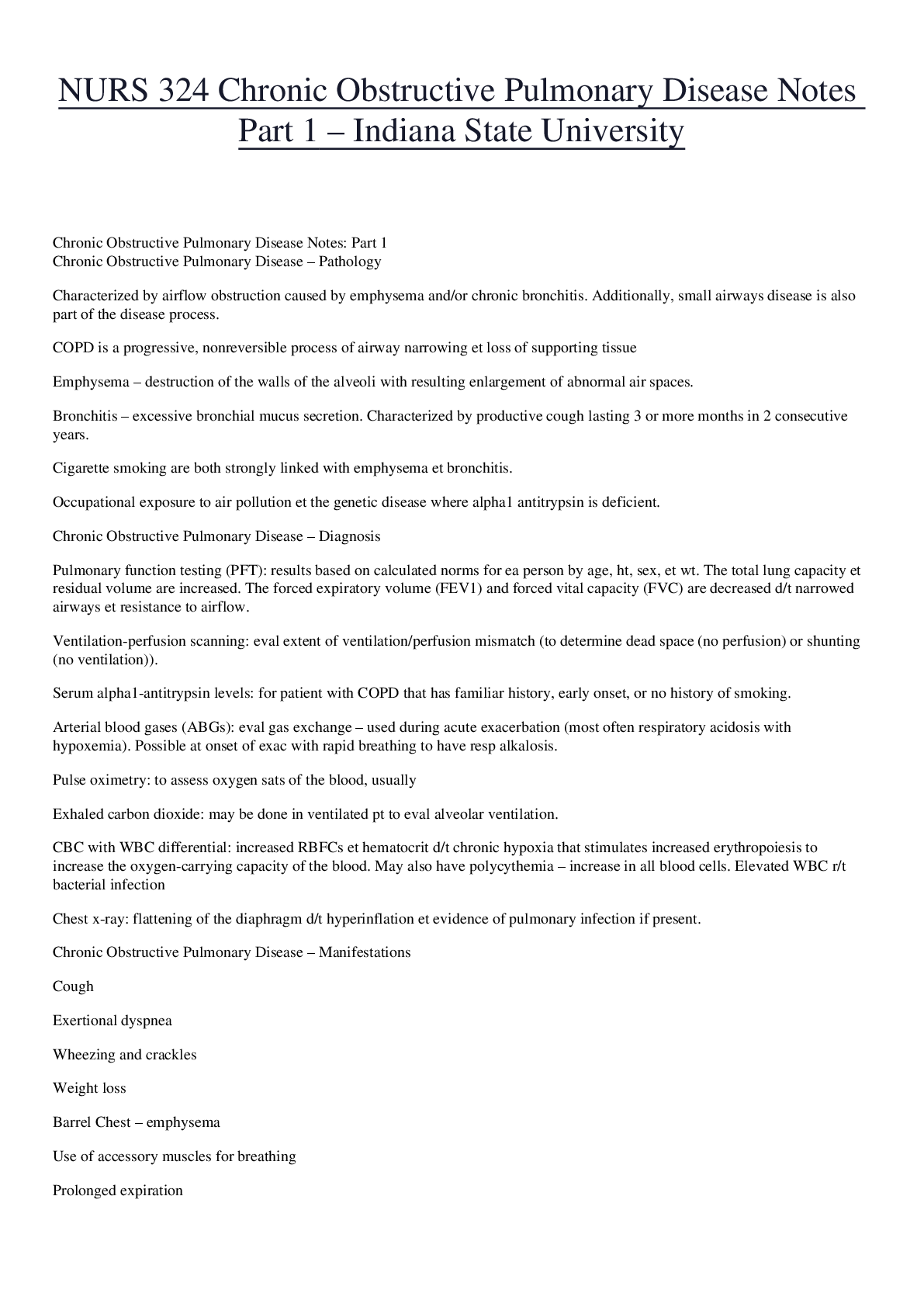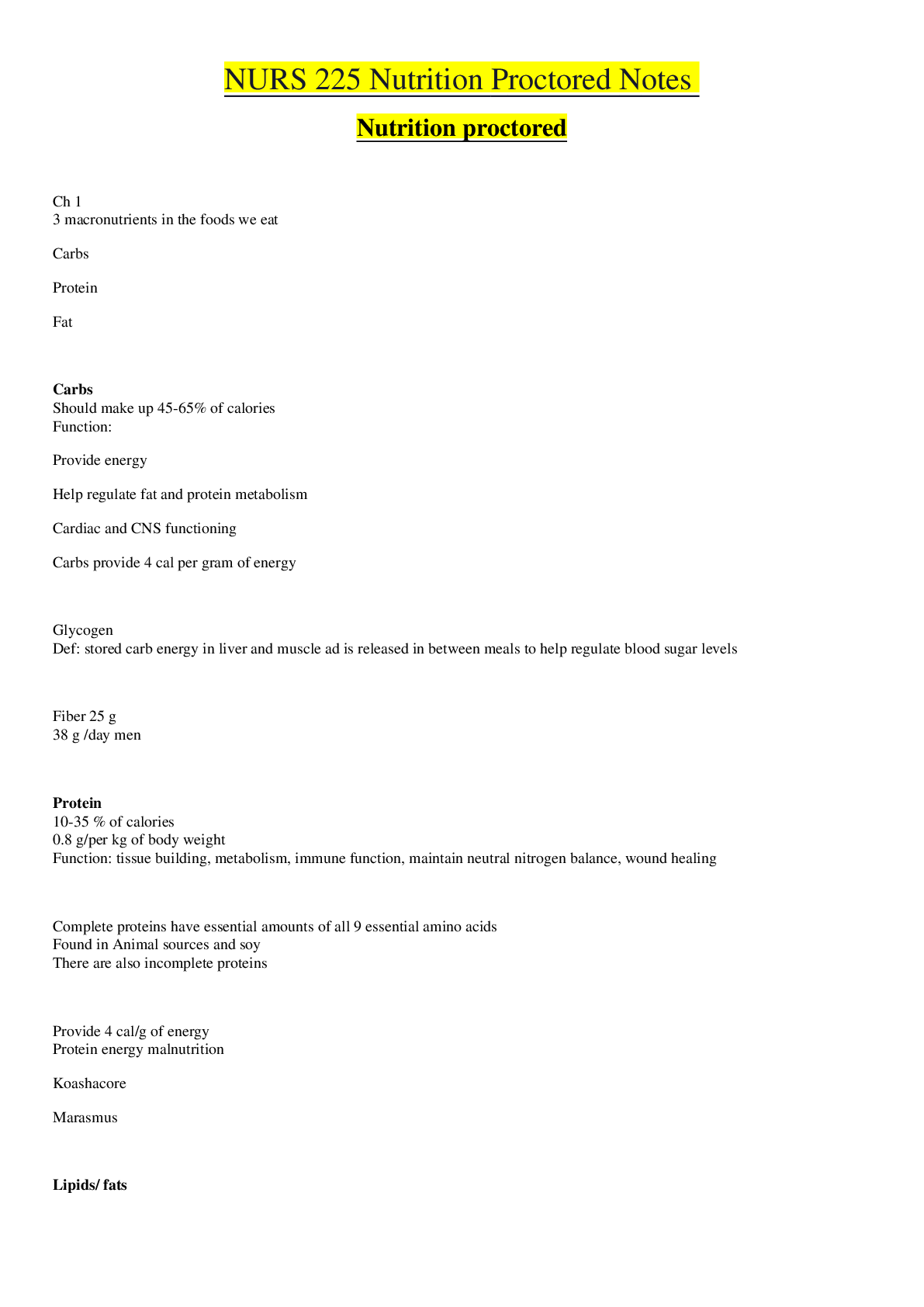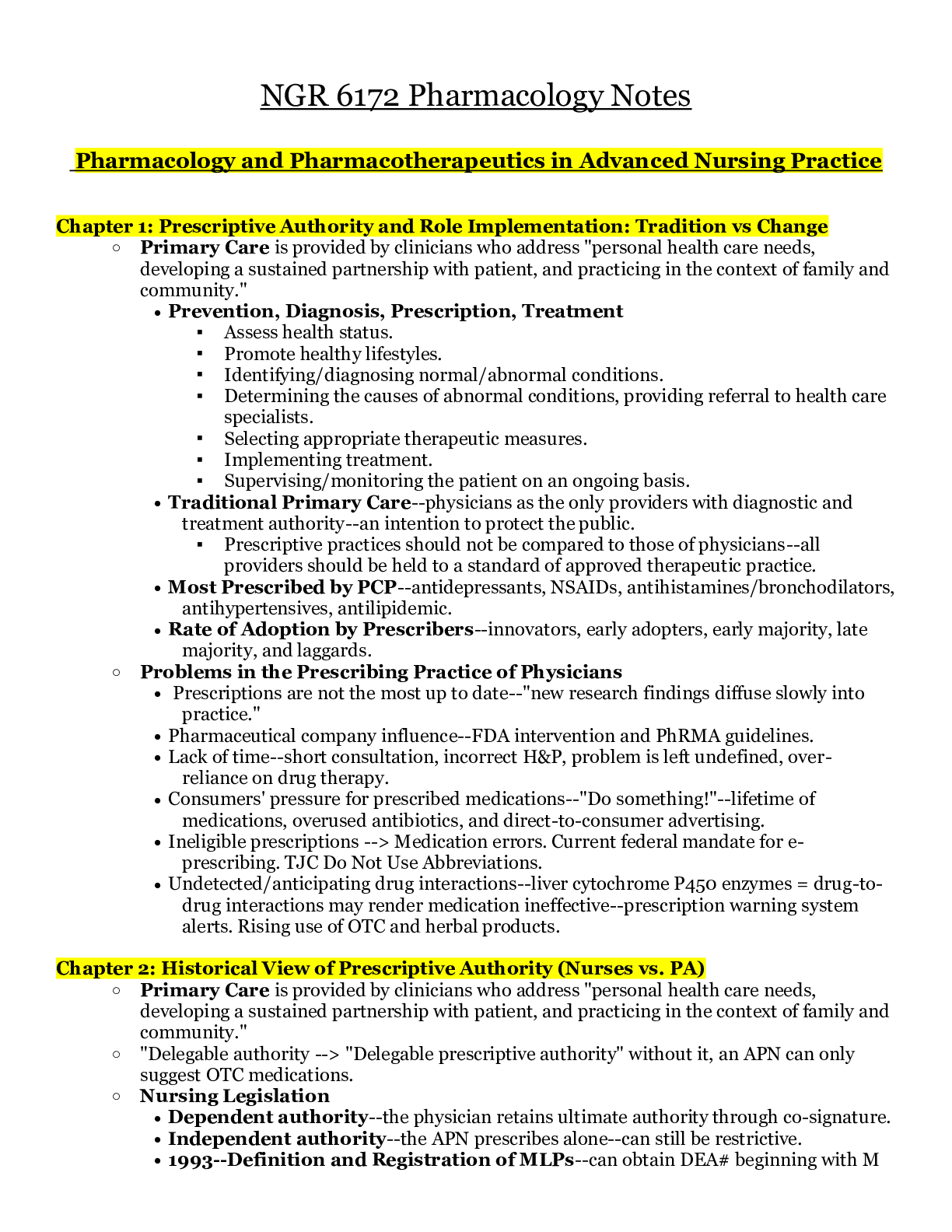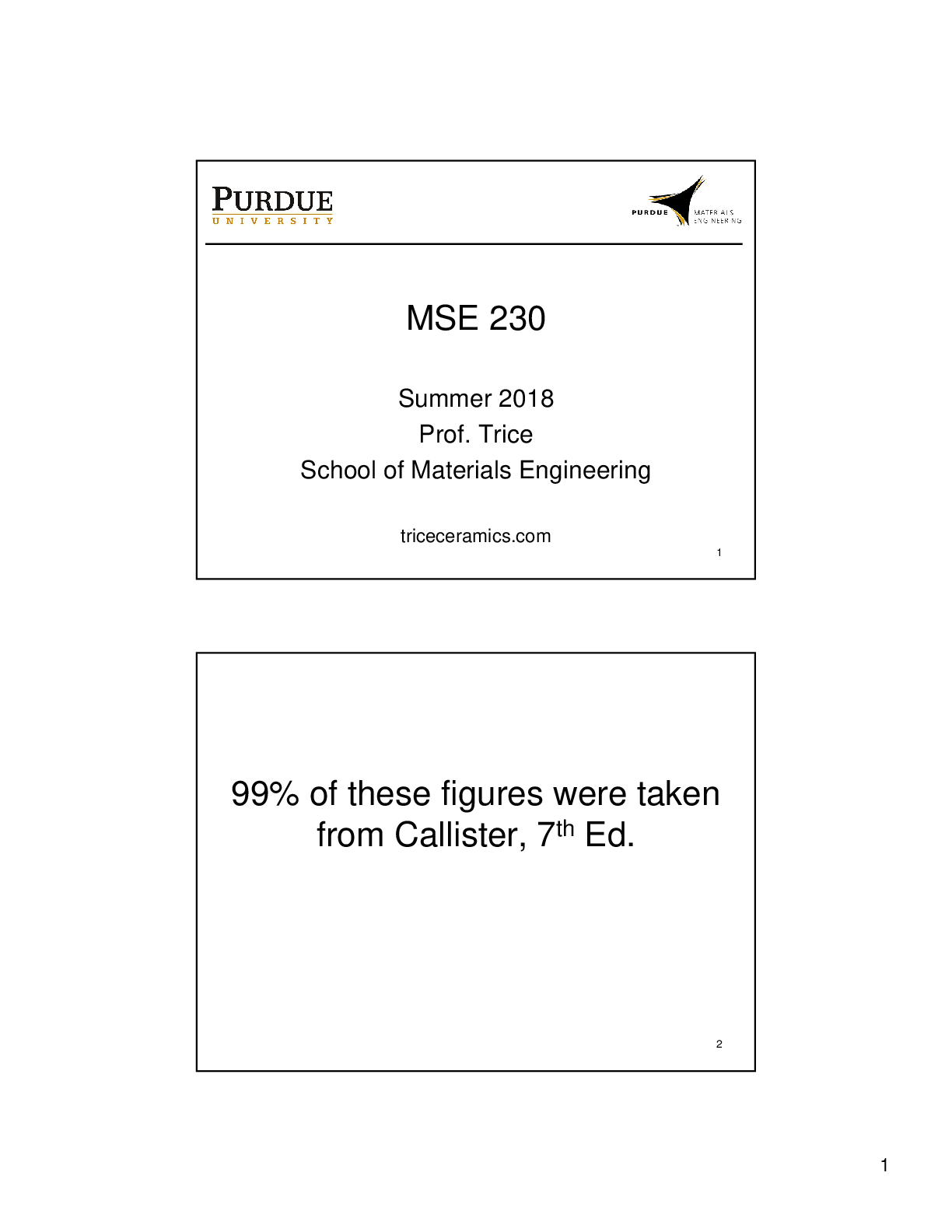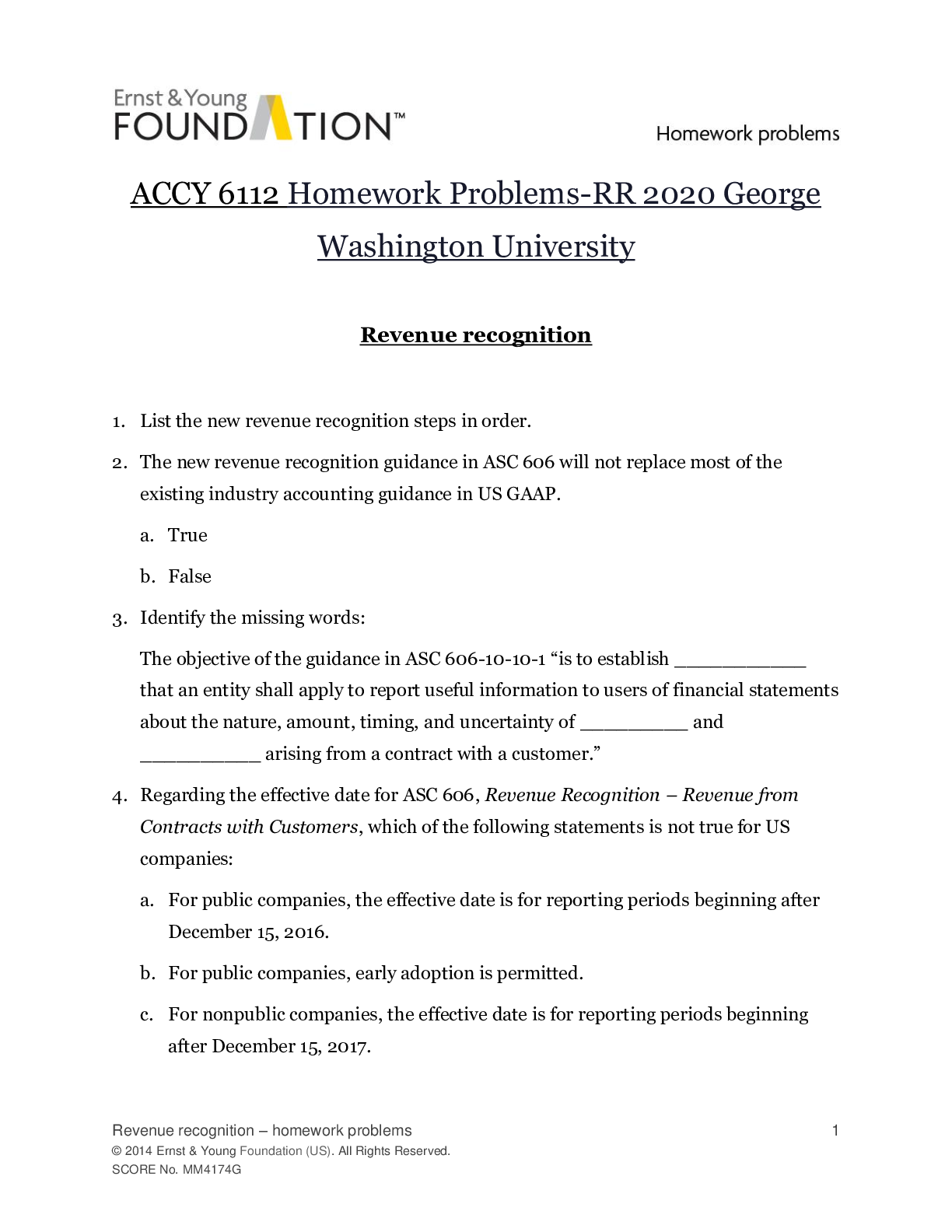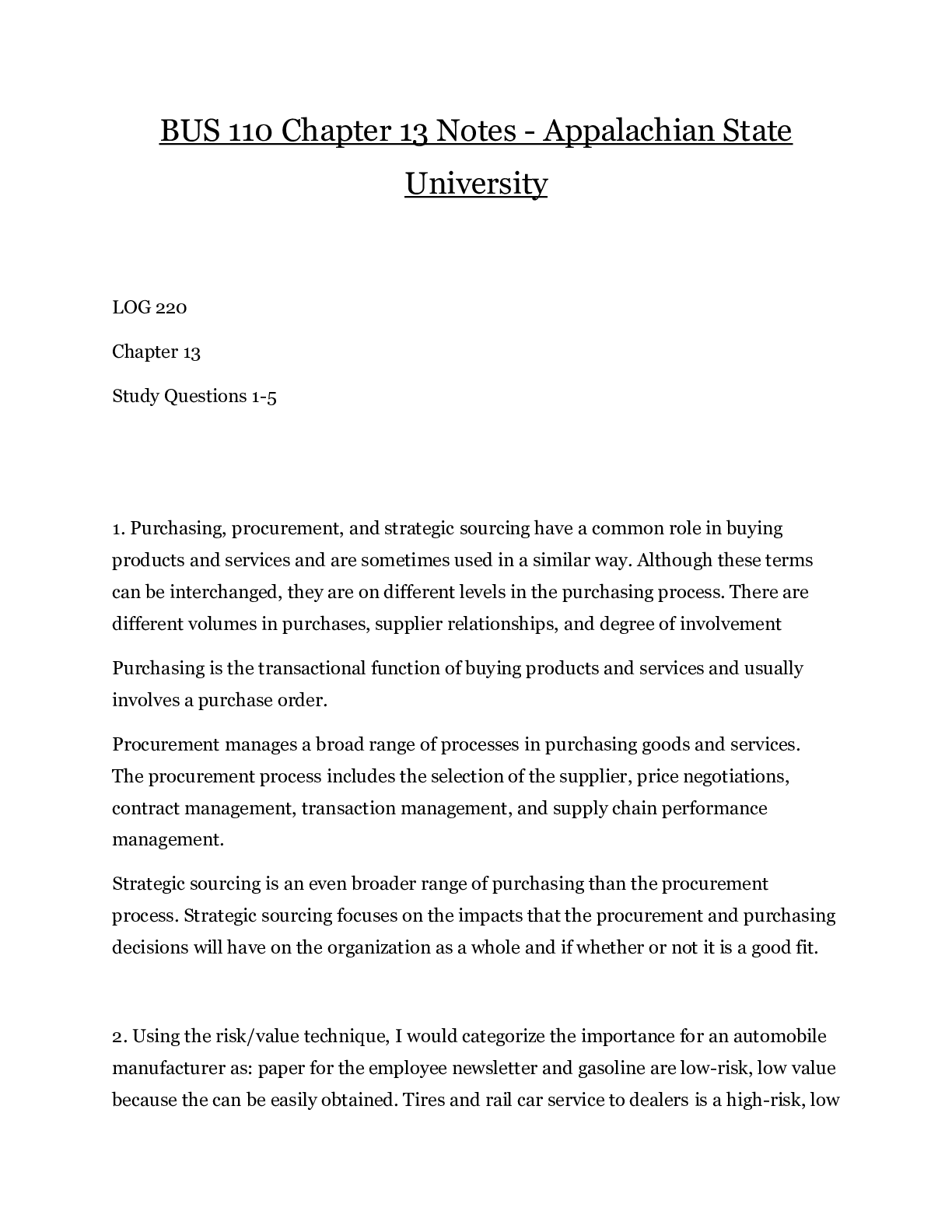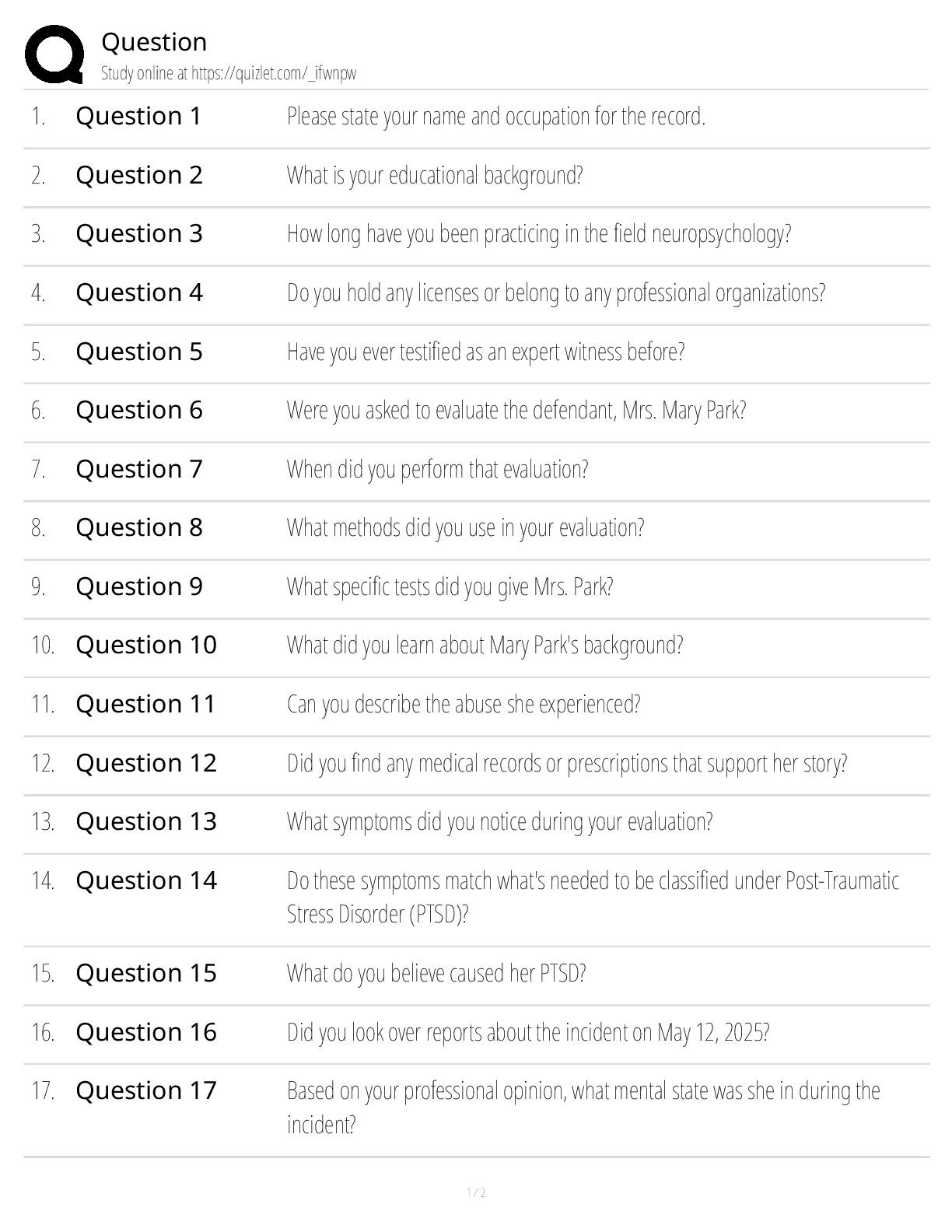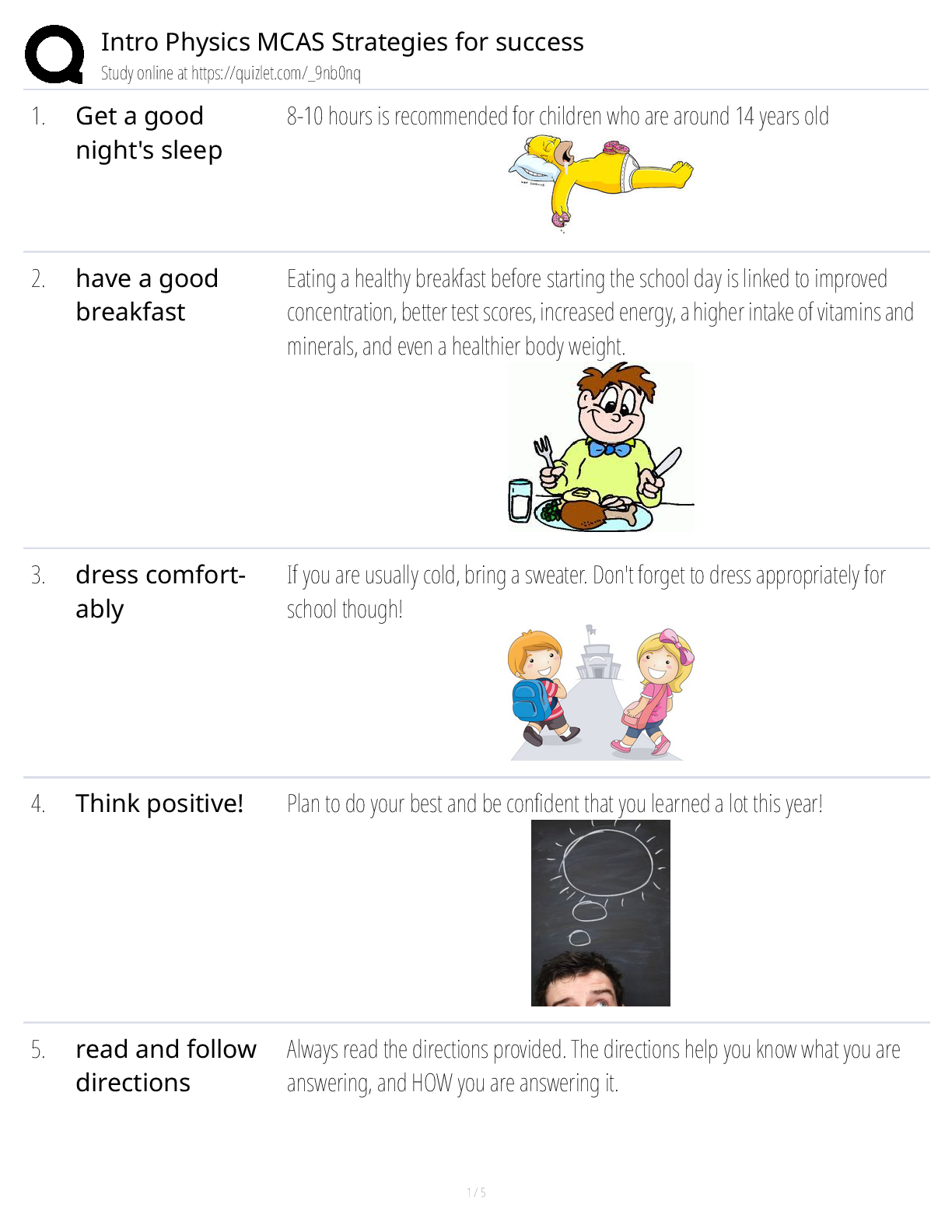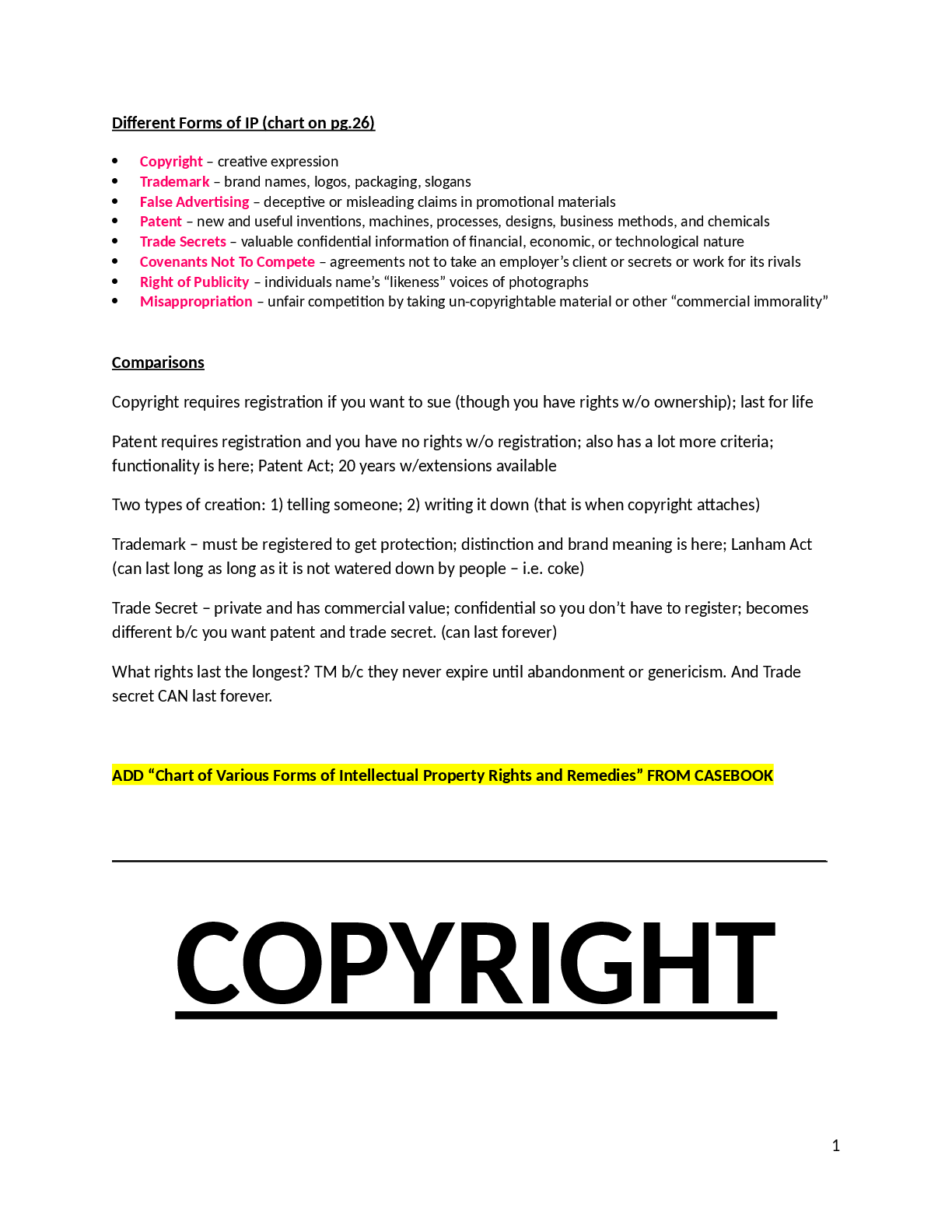Engineering > Class Notes > MSE_230_Notes 2020_with_no_Cartoons_Update_2_per_page - Purdue University | MSE230_Notes 2020_with_n (All)
MSE_230_Notes 2020_with_no_Cartoons_Update_2_per_page - Purdue University | MSE230_Notes 2020_with_no_Cartoons_Update_2_per_page
Document Content and Description Below
MSE 230 Summer 2020 Prof. Trice School of Materials Engineering triceceramics.com 1 99% of these figures were taken from Callister, 7th Ed. 22 3 Lecture 1 First Day of Any Semester 4 Lect ... ure 1 First Day of MSE 230 – Prof. Trice MSE 230 - Trice3 5 Lecture 1 Background on Prof. Trice MSE 230 - Trice 1983-1987 BS in Mechanical Engineering 1988-1989 MS in Materials Science 1989-1991 Lockheed Martin Aerospace 1991-1995 Northrup Grumman Aerospace 1995-1997 Ph.D. in Materials Science and Engineering (University Of Michigan) 1998-2000 Post Doctoral Research Associate (Northwestern University) 2000 - Purdue University – Assistant Professor 2006 - Purdue University – Associate Professor 2009 – Sabbatical at Sandia National Laboratory in NM 2013 – Full Professor 6 Lecture 1 First Day of MSE 230 – Prof. Trice4 7 Lecture 1 Syllabus for MSE 230 8 What are Prof. Trice’s Pet Peeves? Lecture 15 9 What Do You Think a Professor’s Job Is in the Classroom? Lecture 1 10 What Do You Think a Student’s Job Is in the Classroom? Lecture 16 11 What are the 3 Classes of Materials? Lecture 1 12 Lecture 1 Materials Around Campus7 13 Reminder MSE 230 - Trice 1. Login into Blackboard and download the lecture notes! You will not be able to keep up otherwise. 2. Homework! Keep up with it! Quiz this week Friday. 3. Email me [email protected] or your TA if you are having difficulty in the class 4. I look forward to this semester! Lecture 1 14 Lecture 1 Materials Around Campus8 15 Atom Attractions Much of materials science comes down to: 1. Bonding 2. Microstructure Lecture 2 MSE 230 - Trice Tennis balls, flexure specimens 16 Lecture 2 Properties Overview of 3 Classes of Materials Class Density g/cm3 Stiffness (GPa) Thermal Conduct W/m/k Electrical Conduct 1/ohm-m Metal Ceramic Polymer Why are there huge differences between classes of materials? (I will put bonding into primary ( ) and secondary ( ) classes.9 17 Lecture 2 Bonding Types: Primary (3) and Secondary (1) MSE 230 - Trice 1. Primary – Ionic Bonding: Exchange a valence e- to achieve a electronic configuration 2nd Quantum # (subshell) Q. What is the stable configuration for each atom? Na (lose 1 e-) Cl (gain 1 e-) So, sodium is more than willing to give an e- to Cl 18 Lecture 2 MSE 230 - Trice Bonding Types: Primary and Secondary 2. Primary – Covalent: Local sharing of Metalloids like Ex. Carbon 1s22s22p2 -If C can obtain ____ e- it can reach a -Carbon is unique as it promotes ____ e- to a ___ site sp3 Hybridization10 19 Lecture 2 Bonding Types: Primary and Secondary 3. Primary – Metallic: Global sharing Sea of valence e-, loosely bonded Ex. Copper ...3p63d104s1 20 Lecture 2 MSE 230 - Trice Bonding Types: Primary and Secondary 1. Secondary – Van der Waals: Bonding due to dipoles Def. of dipole: opposite charges separated by a distance Q.: how do dipoles occur in atoms? For a brief moment,11 21 Lecture 2 General Approach to Bonding MSE 230 - Trice How is force related to energy? Q. How do two atoms interact when brought near – assume Na, Cl 22 Lecture 2 General Approach to Bonding, Cont. MSE 230 - Trice r o is the Eo is the energy well; energy required to pull 2 atoms to Big Idea: shape and depth of energy well depend on bond type which, in turn, Influences engineering properties.12 23 Lecture 2 Applications MSE 230 - Trice 1. E o varies with bond type E o ionic E o cov E o metallic E o vdw 2. E o value influences Tmelt Material E o (kJ/mol) T melt Bond Type Al Fe NaCl C (dia) Ar Remember that E o is the energy required to pull atoms to infinite separation - akin to melting 24 Lecture 2 Applications Cont. MSE 230 - Trice 3. Stiffness of the material is a function of bonding energy (F vs. r curve) - Slope of line @ ro - As E o increases, typically see an increase in stiffness13 25 Applications Cont. 4. Shape/symmetry of energy well influences the Coefficient of Thermal Expansion (CTE) upon heating/cooling CTE (units of 1 x 10-6/oC) – the expansion of a material with an increase in temperature or shrinkage of a material with a decrease in temperature Railroad tracks were assembled with no understanding of the effects of CTE What is the origin of CTE in a material? ANSWER: The average equilibrium distance between the atoms is increasing as temperature increases (and vice versa) Manifests itself as change in www.upscale.utoronto.ca 26 Lecture 2 MSE 230 - Trice Applications Cont. 4. Shape/symmetry of energy well influences the coefficient of thermal expansion upon heating/cooling Atom moves between two extremes; r# is the average distance Materials with large Eo typically have more symmetrical wells, therefore low CTEs r# increases as temperature increases, therefore sample gets Symmetric well? Then14 27 Summary Lecture 2 MSE 230 - Trice 1. 3 primary bonding types: Ionic, covalent, metallic 2. 1 Secondary bonding type: Van der waals bonding due to dipole interactions 3. The Tmelt, elastic modulus or stiffness, density, electrical and thermal properties, and CTE are important engineering properties that are a function of bonding. Homework 1 28 How Atoms Self-Organize -- Crystals Last time • Specific bonding between atoms • General bonding between 2 atoms Today • How atoms come together in a real material MSE 230 - Trice 3 Primary: 1 Secondary: Lecture 3 BCC and FCC models, penny15 29 Real Materials • Made up of more than • Most materials are Q. But how do atoms come together in a real material? How will they organize themselves? Answer: Unit cell → basic building block Copper penny has 7 unique unit cells, and only 14 unique ways to put atoms on those unit cells 30 Images from A. Putnis, Introduction to Mineral Sciences Body Centered Cubic or Face Centered Cubic or Hexagonal Close Packed or Cubic Tetragonal Orthorhombic Monoclinic Triclinic Trigonal Hexagonal16 31 Models of Common Crystals MSE 230 - Trice 1. Which one has an atom contained in it? 2. How many corner atoms in each? 3. How many face atoms in FCC? 4. Which unit cell is bigger? 5. Coordination number? BCC = FCC = 6. Packing fraction of atoms? http://www.youtube.com/watch?v=RoyzZUJfo-Y http://www.youtube.com/watch?v=Co550Yn7QVc Densest way to pack monodisperse spheres, whether bowling balls or atoms, is represented in the ______ unit cell. 32 MSE 230 - Trice FCC: /81 Metals Crystal System Corner Atoms Face Atoms Atoms Inside Total Atoms /unit cell Lattice Constant, a, in terms of R Coordination Number Atomic Packing Factor Material Examples Face Centered Cubic http://www.youtube.com/watch?v=RoyzZUJfo-Y a = lattice parameter17 33 Example: Relating a to R: FCC 4R a a Hint: atoms must touch to perform this calculation! 34 BCC: /81 Metals Crystal System Corner Atoms Face Atoms Atoms Inside Total Atoms /unit cell Lattice Constant, a, in terms of R Coordination Number Atomic Packing Factor Material Examples Body Centered Cubic http://www.youtube.com/watch?v=Co550Yn7QVc a = lattice parameter18 35 Example Calculation of Atomic Packing Fraction 1. BCC APF = (# Atoms/Unit Cell)(volume of an atom) Total Volume Unit Cell 36 Hexagonal Close Packed (HCP): /81 Metals Crystal System Corner Atoms Face Atoms Atoms Inside Total Atoms /unit cell Lattice Constant, a, in terms of R Coordination Number Atomic Packing Factor Material Examples HCP19 37 Allotrophy (Polymorphism) MSE 230 - Trice Two Points 1. Only one crystal 2. Density change associated with state in crystal structure Def.: Materials with more than one crystal system. TEMP BCC (PF=0.68) FCC (PF=0.74) BCC (PF=0.68) 38 Directions in Crystals MSE 230 - Trice Why we care: metals deform along directions of greatest linear density between planes of greatest planar density20 39 MSE 230 - Trice Identification of Planes (Miller Indices) 40 Anisotropy MSE 230 - Trice - Properties that vary as a function of the direction in a crystal Cu, FCC E, GPa [100] [110] [111] Fe, BCC [100] [110] [111] Average Modulus = Average Modulus =21 41 Summary • BCC and FCC atomic structures are unique; it is important to get comfortable with each structure and its unique atomic arrangements • Direction and plane designations in crystals provide a means to name important aspects of each crystal type; knowing these will become important at we discuss mechanical deformation • Crystals are anisotropic, ie. there are different properties associated with different directions in the crystals. Additional Info: When we calculate linear density - we think in 1D (the line cuts a fraction of the atom width); When we calculate planar density, we think in 2d (the plane encompasses some fraction of the atom area); When we calculate atomic packing fraction, we think in 3d (the unit cell encompasses some volume of the atom) 42 Crystal System Corner Atoms Face Atoms Atoms Inside Total Atoms /unit cell Lattice Constant, a, in terms of R Coordination Number Atomic Packing Factor Material Examples Body Centered Cubic Face Centered Cubic Hexagonal Close Packed Overview of Common Crystals22 43 Grains and X-Rays MSE 230 - Trice 44 If this is a piece of pure Al at 200x what are the features we observe under the microscope? Answer 1. Grain: 3D region with the same 2. Grain Boundary: disordered region between grains; dislocations form here (talk more about these important features later) Optical Microscope Images23 Don’t Forget! Grains are 3D We image grains in an optical microscope (using light) or a scanning electron microscope (using electrons) in 2D but remember they are 3D in shape Grains are not typically spherical due to other energy considerations Picture taken Sept 29, 2018 at Denver Beerfest 46 Polycrystallinity • How many grains in a paperclip? • Most engineering materials are made up of • Same crystal type, but oriented 1. Turbine Blades Notable Exceptions: Where we use single crystals (1 grain) 2. Si wafers24 47 Review 1. Atoms make up 2. String together thousands of units cells to make a (a grain is simply a single crystal of material) 3. Most Eng. Materials are made up of many 4. Each grain is at a different orientation relative to the surrounding grains and that is why we observe 48 How Do Grains Form? Question: How do we investigate crystalline materials? MSE 230 - Trice Start with a liquid, cool below the melting temperature As a side note, there are other ways that grains form in materials25 49 MSE 230 - Trice X-Ray Diffraction Basics • Used to investigate crystalline materials • Long range order of atoms Incoming Rays Outgoing Rays 1. Specimen and series of parallel planes, viewed edge on, each parallel to the surface 2. “Shine” x-rays on sample 3. X-rays penetrate surface 4. Interaction of the x-rays with the material affords ____ possibilities 50 MSE 230 - Trice 2 Possibilities for the Outgoing X-Rays (ii) Outgoing Rays In-Phase (Mutually Reinforce) (i) Outgoing Rays Out-of-Phase Q. Why would the outgoing waves sometimes be in phase? https://www.youtube.com/ watch?v=DUssYdpjVmU • Waves ____________ reinforce • Amplitude of wave __________ • Called ______________26 51 Bragg’s Law Derivation Answer: Mutual reinforcement of the scattered rays occurs if the extra distance traveled by ray 2-2’ compared to ray 1-1’ is equal to the λ of the radiation. When this occurs it is called “diffraction.” If 1-1’ travels some distance (interacts with only the top plane), how much longer does 2-2’ travel? We can get the answer from simple geometrical considerations. Bragg’s Law: 52 How Does XRD Work in the Laboratory 2Θ Random arrangement of ___________ and assume some are parallel to surface Big Idea: Each peak corresponds to a27 53 MSE 230 - Trice Repeating Identical Planes We need an expression for dhkl Identical Planes – planes parallel to each other (see above) Equivalent Planes – have the same planar density, but can be oriented in space differently 54 Focus on d → Spacing Between Planes MSE 230 - Trice Plane spacing depends on: 1. Atom size (because it changes the lattice parameter) 2. Temperature (because it changes the lattice parameter) 3. Stress (because it changes the lattice parameter) dhkl = Example Problem: Is d200 for Pb the same as d200 for Ni? R Pb = 0.175 nm RNi = 0.125 nm Q. Which planes diffract (not all do)?28 55 Which Sets of Parallel Planes Can Diffract? MSE 230 - Trice Let’s make of list of allowed diffraction planes taking on faith the following rules: i. Allowed planes for BCC: h + k + l = even ii. Allowed planes for FCC: hkl all even or all odd planes are closer spaced 2Θ increasing Grain 1 Grain 2 Grain 3 d220 d220 d200 • Assume for this example that the grains are from a BCC crystal where h + k + l = even must be satisfied for diffraction to be possible. • All grains have multiple sets of different parallel planes like shown in Grain 2. But only planes parallel to the surface can diffract – so the {220} planes in grain 1 will not diffract but the {220} planes in grain 2 will diffract. In a randomly oriented sample, some of the grains will be positioned so that some of the possible diffracting planes are parallel to the surface. • The {200} planes in grain 3 will also diffract for BCC, but because the d-spacing is larger, the peak will occur at a smaller 2Θ than the diffraction peak from the {220} planes in grain 2. Incoming and Scattered X-rays Sample Surface X-rays penetrate 20-100 microns below surface A Closer Look at the Sample and Diffraction Θ29 57 1. Can {112} be diffracted in BCC? 2. Calculate d experimental 3. Calculate d112 for BCC-Fe Example Problem So, the peak shown above _____ _______ from the {112} family of planes of BCC Iron. 58 Summary 1. Almost all engineering materials are made up of many grains (Notable expections: gas turbine blades, Si semiconductors 2. Grains form as a result of solidification from the melt or from using powders to form the object (discuss later in ceramic section) 3. Bragg diffraction (mutual reinforcement or constructive interference) occurs if the path difference in the scattered (or outgoing rays) is equal to a whole number, n (i.e. 1, 2, 3 but n=1) of the wavelength of the radiation. 4. Crystalline materials diffract X-rays in characteristic ways depending on crystal structure and atomic size (think fingerprints). Homework 230 59 Lecture 5 MSE 230 - Trice Famous Failures: A. Why do we worry about mechanical properties? Introduction to Deformation of Materials 60 Lecture 5 MSE 230 - Trice Famous Failures: Boeing 737 Aloha Airlines Introduction to Deformation of Materials31 61 Lecture 5 MSE 230 - Trice Common Failures: Introduction to Deformation of Materials 62 Lecture 5 MSE 230 - Trice B. Why do materials have different properties? C. Do I only have to worry about when I design a part? Other design criteria: D. What methods to characterize a material - - - - - - - - - - - - - - - - - - - - - - -- - - - - -- Shrinkage/Water Loss Continued Plain Sawed Quarter Sawed Q. Which cut of wood shrinks the least? L, t, r Lecture 28170 339 Wood Type ρ, g/cm3 MORL (MPa) EL (GPa) Eastern White Pine (Soft) White Oak (Hard) MSE 230 - Trice Effect of Moisture (Water Content) on Mechanical Properties GR: Green states KD: Kiln dried to _________ % moisture Notice that strength is proportional to the density Lecture 28 340 MSE 230 - Trice Mechanical Properties of Wood Elastic Modulus (Douglass Fir), in GPa Toughness, MPa-m0.5 E L = E t = E r = K pine (perpendicular to cells) K pine (parallel to cells) K oak (perpendicular to cells) K oak (parallel to cells) Wood splitting is easier when splitting ______________ cells. Lecture 28171 341 How to Get Around Anisotropy in Wood Oriented Strand Board (OSB) Particle Board Plywood Veneer Isotropic = No directional dependence on properties such as E, σ (polycrystalline Cu) Orthotropic = Same properties in the plane, but not out of plane (quasi-isotropic epoxy/graphite composites) Anisotropic = Properties vary in all 3 directions (single crystal of Cu, 2x4 of white pine) Lecture 28 https://www.youtube.com/watch?v=Jn4k2TPIJf0 Nothing is wasted! I O A I O A I O A 342 MSE 230 - Trice Asphalt - asphalt is a _________________ (a petroleum product); it is a thermoplastic - Asphalt is always laid above the flow properties of the bitumen, allowed to cool before it is driven on - During hot Texas summers, the asphalt can actually flow or at least become very sticky Lecture 28172 343 Summary • Trees follow structure-property relationships just like all materials • Softwoods and hardwoods have different properties; related to the make-up of the cells/microstructure; properties of wood generally correlate to density. • Moisture content plays a large role in the properties of wood • Asphalt and concrete are also important composite materials MSE 230 - Trice Lecture 28 344 Review Info173 345 Important Temperatures Overview All temperatures in oC -196 -100 -50 25 100 260 150 - 200 660 727 800 700 - 1000 1050 1147 1538 2060 3550 1 2 3 4 5 6 7 8 9 10 11 12 13 14 15 16 346 Stuff Every Engineer Should Know The elastic modulus (GPa) of steel? Aluminum? Polyethylene? The density (g/cm3) of steel? Aluminum? Most polymers? The three primary bonding types: In terms of electrons? Properties determined by bonding include: modulus, conductivity, CTE, density 5 ways to strengthen a metal: grain size reduction, cold working, alloying, martensitic, precipitation hardening Microstructure can be altered by processing!! Copper is the ________ thermal conductor (about 400 W/m-K), has an electrical conductivity of about ___________ mho/m (ceramics are 10-12 mho/m) FCC crystals have __________ Tm, ______ conductive, _______ ductility BCC crystals have have __________ Tm, ______ conductive, _______ ductility 90% of all mechanical failures are due to Almost all reactions involve ______________ of atoms (name for movement of atoms) Thermoplastic polymers are re-_____________; thermosets are not17 [Show More]
Last updated: 3 years ago
Preview 1 out of 174 pages
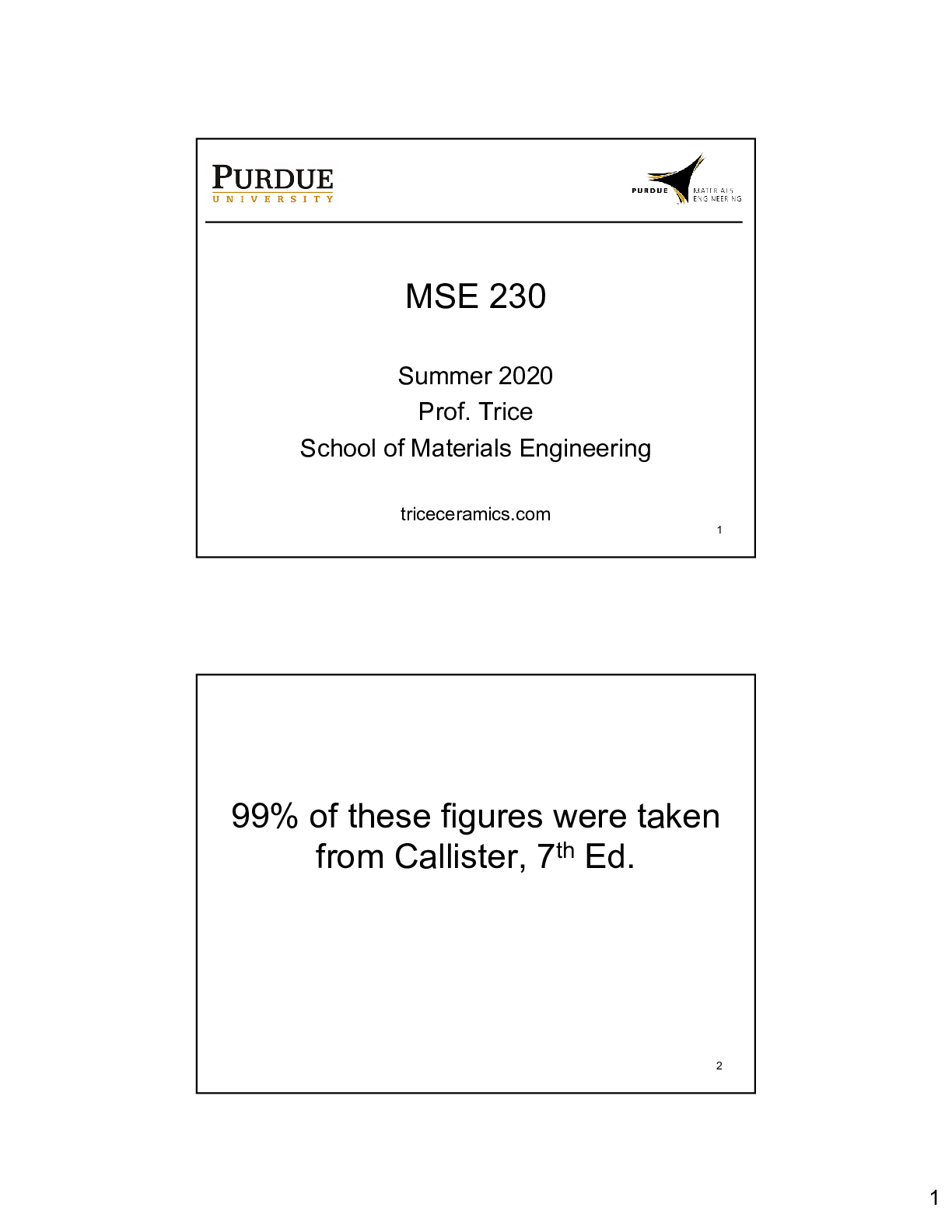
Buy this document to get the full access instantly
Instant Download Access after purchase
Buy NowInstant download
We Accept:

Reviews( 0 )
$18.50
Can't find what you want? Try our AI powered Search
Document information
Connected school, study & course
About the document
Uploaded On
Nov 22, 2020
Number of pages
174
Written in
All
Additional information
This document has been written for:
Uploaded
Nov 22, 2020
Downloads
0
Views
175

